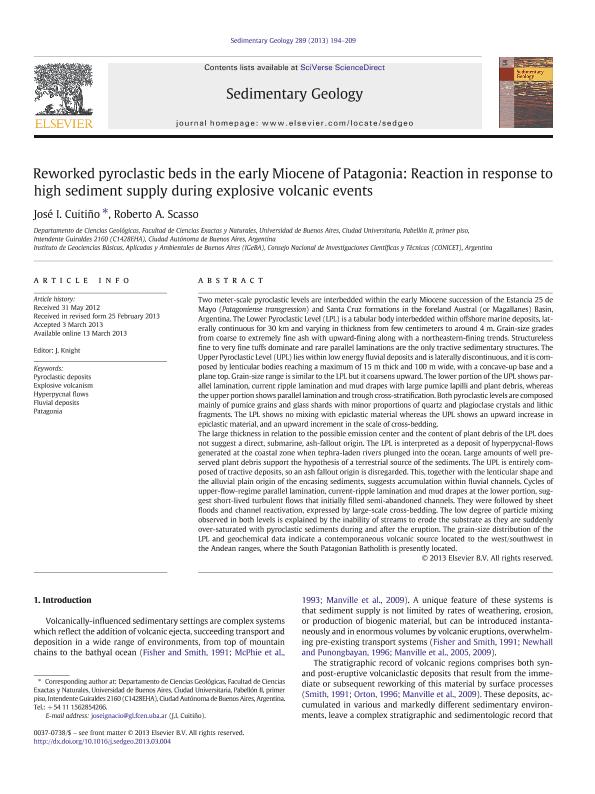Mostrar el registro sencillo del ítem
dc.contributor.author
Cuitiño, José Ignacio

dc.contributor.author
Scasso, Roberto Adrian

dc.date.available
2017-04-27T15:20:39Z
dc.date.issued
2013-05
dc.identifier.citation
Cuitiño, José Ignacio; Scasso, Roberto Adrian; Reworked pyroclastic beds in the early Miocene of Patagonia: Reaction in response to
high sediment supply during explosive volcanic events; Elsevier Science; Sedimentary Geology; 289; 5-2013; 194-209
dc.identifier.issn
0037-0738
dc.identifier.uri
http://hdl.handle.net/11336/15788
dc.description.abstract
Two meter-scale pyroclastic levels are interbedded within the early Miocene succession of the Estancia 25 de Mayo (Patagoniense transgression) and Santa Cruz formations in the foreland Austral (or Magallanes) Basin, Argentina. The Lower Pyroclastic Level (LPL) is a tabular body interbedded within offshore marine deposits, laterally continuous for 30 km and varying in thickness from few centimeters to around 4 m. Grain-size grades from coarse to extremely fine ash with upward-fining along with a northeastern-fining trends. Structureless fine to very fine tuffs dominate and rare parallel laminations are the only tractive sedimentary structures. The Upper Pyroclastic Level (UPL) lies within low energy fluvial deposits and is laterally discontinuous, and it is composed by lenticular bodies reaching a maximum of 15 m thick and 100 m wide, with a concave-up base and a plane top. Grain-size range is similar to the LPL but it coarsens upward. The lower portion of the UPL shows parallel lamination, current ripple lamination and mud drapes with large pumice lapilli and plant debris, whereas the upper portion shows parallel lamination and trough cross-stratification. Both pyroclastic levels are composed mainly of pumice grains and glass shards with minor proportions of quartz and plagioclase crystals and lithic fragments. The LPL shows no mixing with epiclastic material whereas the UPL shows an upward increase in epiclastic material, and an upward increment in the scale of cross-bedding. The large thickness in relation to the possible emission center and the content of plant debris of the LPL does not suggest a direct, submarine, ash-fallout origin. The LPL is interpreted as a deposit of hyperpycnal-flows generated at the coastal zone when tephra-laden rivers plunged into the ocean. Large amounts of well preserved plant debris support the hypothesis of a terrestrial source of the sediments. The UPL is entirely composed of tractive deposits, so an ash fallout origin is disregarded. This, together with the lenticular shape and the alluvial plain origin of the encasing sediments, suggests accumulation within fluvial channels. Cycles of upper-flow-regime parallel lamination, current-ripple lamination and mud drapes at the lower portion, suggest short-lived turbulent flows that initially filled semi-abandoned channels. They were followed by sheet floods and channel reactivation, expressed by large-scale cross-bedding. The low degree of particle mixing observed in both levels is explained by the inability of streams to erode the substrate as they are suddenly over-saturated with pyroclastic sediments during and after the eruption. The grain-size distribution of the LPL and geochemical data indicate a contemporaneous volcanic source located to the west/southwest in the Andean ranges, where the South Patagonian Batholith is presently located.
dc.format
application/pdf
dc.language.iso
eng
dc.publisher
Elsevier Science

dc.rights
info:eu-repo/semantics/openAccess
dc.rights.uri
https://creativecommons.org/licenses/by-nc-nd/2.5/ar/
dc.subject
Pyroclastic Deposits
dc.subject
Explosive Volcanism
dc.subject
Hyperpycnal Flows
dc.subject
Fluvial Deposits
dc.subject.classification
Geología

dc.subject.classification
Ciencias de la Tierra y relacionadas con el Medio Ambiente

dc.subject.classification
CIENCIAS NATURALES Y EXACTAS

dc.title
Reworked pyroclastic beds in the early Miocene of Patagonia: Reaction in response to
high sediment supply during explosive volcanic events
dc.type
info:eu-repo/semantics/article
dc.type
info:ar-repo/semantics/artículo
dc.type
info:eu-repo/semantics/publishedVersion
dc.date.updated
2017-04-24T20:41:56Z
dc.journal.volume
289
dc.journal.pagination
194-209
dc.journal.pais
Países Bajos

dc.journal.ciudad
Amsterdam
dc.description.fil
Fil: Cuitiño, José Ignacio. Consejo Nacional de Investigaciones Científicas y Técnicas. Oficina de Coordinación Administrativa Ciudad Universitaria. Instituto de Geociencias Basicas, Aplicadas y Ambientales de Buenos Aires. Universidad de Buenos Aires. Facultad de Ciencias Exactas y Naturales. Instituto de Geociencias Basicas, Aplicadas y Ambientales de Buenos Aires; Argentina
dc.description.fil
Fil: Scasso, Roberto Adrian. Consejo Nacional de Investigaciones Científicas y Técnicas. Oficina de Coordinación Administrativa Ciudad Universitaria. Instituto de Geociencias Basicas, Aplicadas y Ambientales de Buenos Aires. Universidad de Buenos Aires. Facultad de Ciencias Exactas y Naturales. Instituto de Geociencias Basicas, Aplicadas y Ambientales de Buenos Aires; Argentina
dc.journal.title
Sedimentary Geology

dc.relation.alternativeid
info:eu-repo/semantics/altIdentifier/doi/http://dx.doi.org/10.1016/j.sedgeo.2013.03.004
dc.relation.alternativeid
info:eu-repo/semantics/altIdentifier/url/http://www.sciencedirect.com/science/article/pii/S0037073813000420
Archivos asociados
